SILVANA MOSSANO
Reportage udienza lunedì 8 novembre 2021
Confesso: la tentazione, forte e istintiva, l’ho avuta. La tentazione di limitarmi a fare una sintesi delle diciotto testimonianze che hanno impegnato l’udienza di lunedì 8 novembre, in Corte d’Assise a Novara, nel processo Eternit Bis, in cui l’imprenditore svizzero Stephan Schmidheiny deve rispondere dell’omicidio volontario (con dolo eventuale) di 392 persone di Casale e dintorni morte a causa dell’esposizione all’amianto. La tentazione di raccogliere tutte quelle voci in un unico racconto collettivo, mantenendo il senso e senza tralasciare nulla, certo, ma passando attraverso il filtro dell’«insieme», che sfuma sugli spigoli, che sfugge i dettagli, che rende un po’ più sopportabile la tragedia se narrata in modo corale.
Una formula di umana autoprotezione (così mi sono detta, invocando una pur blanda assoluzione), ma al tempo stesso una pavida scappatoia (alla fine l’ho ammesso con me stessa, grattandomi la coscienza con cartavetrata).
Ho avuto la tentazione, sì, lo ammetto, di raccontare rimanendo oltre la porta, stando un passo indietro nell’ascoltare e riportare quelle voci. Ho cercato motivazioni per incoraggiarmi a trovare comprensione in questa scelta: entrare di nuovo in quelle case, mi sono detta, è come rientrare nella tua casa, dove sai che cosa è successo e che cosa succede, sai che cosa si prova, sai come ti paralizza – la nuca, le spalle, la gola e le viscere – il gelo della disperazione, dell’ineluttabilità e dell’impotenza. Sai che faccia ha l’angoscia, la paura e la rassegnazione di chi riceve la diagnosi feroce di mesotelioma.
Poco contano le puntualizzazioni scientifiche: maligno, pleurico, bifasico, sarcomatoide… Mesotelioma è già tutto. Troppo.
Ma quelle voci – di mogli, di figli -, così educate e pacate che si levano da dietro il tavolino loro riservato nell’aula dove si svolge il processo, scuotono più di un tuono d’un temporale d’agosto, spalancano le porte e le finestre, mi costringono a varcare la soglia, ad ascoltare ancora, parola per parola, e a rivivere, senza risparmio, ogni reazione e sentimento.
Devo metterle in ordine, quelle voci, e raccontarle, quelle storie. Tutte. Ognuna di quelle tutte, così come già avvenuto per l’udienza scorsa (25 ottobre) e per altre che verranno. Devo farlo. Per rispetto, per amore, per la memoria.
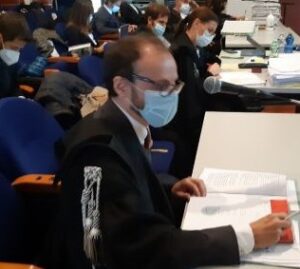
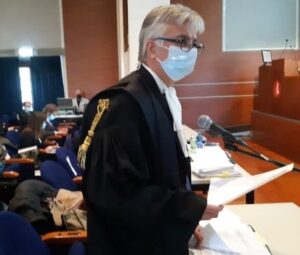
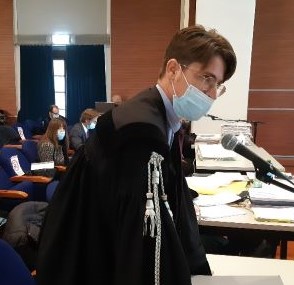
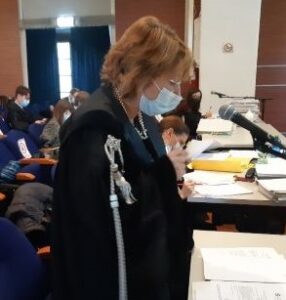
Paola Maria Leporati (costituita parte civile con l’avvocato Enrico Brunoldi), per la morte della madre Maria Raiteri.
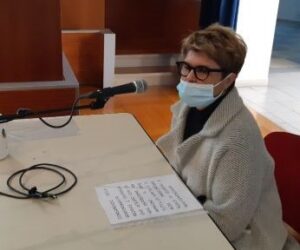
«Era la mia mamma. E’ sempre vissuta a Coniolo, circa sei chilometri da Casale. Da ragazza era contadina; dopo il matrimonio con mio padre, ha cominciato a lavorare nella panetteria dei suoceri che papà, poi, rilevò nel 1972, lasciando il suo posto da operaio all’Eternit; lì, in fabbrica, ci aveva guadagnato l’asbestosi: me lo ricordo bene il fischio del respiro che gli rendeva difficile addormentarsi. La mamma ha dedicato tutta la vita alla famiglia e al lavoro. Mi ha aiutato sempre, e molto, soprattutto dopo la nascita di mio figlio, nel 1995, affetto da una certa disabilità». Con il nipote, bello e dolcissimo, la nonna ha coltivato un rapporto potente e speciale, una presenza costante e importante. «Ad agosto 2008, ha cominciato ad avvertire un dolore al basso ventre; mi sono rivolta ad un amico per una ecografia. “Non mi piace tanto -, mi disse dopo l’esame -, fai fare altri accertamenti”. A ottobre la diagnosi arrivò implacabile. Lei cominciò a soffrire di mancanza d’aria. Ci confrontammo con la dottoressa Daniela Degiovanni (l’oncologa che ha diretto per anni l’Hospice Zaccheo di Casale e l’associazione Vitas, ndr) e concordammo di non fare la chemio, per garantire alla mamma la miglior qualità della vita possibile. A casa, io ho imparato a fare quel che dovevo fare e la curavo secondo le istruzioni che mi venivano date. Lei si è chiusa in sé stessa, era rammaricata di non riuscire più a essere utile. L’ultima settimana, quando la situazione si è aggravata, ho scelto di trasferirla all’hospice, perché mio figlio non dovesse subire direttamente il distacco per la morte della nonna cui era molto affezionato. Lì, all’hospice, siamo stati vicini, circondati da affetto, come essere a casa, in famiglia».
Paolo Scarrone (parte civile con l’avvocato Brunoldi) per la morte del padre Mario Scarrone.
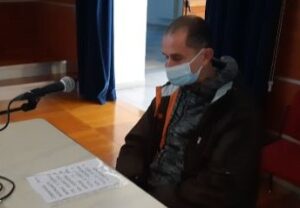
«Mio padre è vissuto a San Germano, frazione di Casale, fino al 1961; poi si è trasferito in città e ha aperto un negozio di casalinghi in via Garibaldi, insieme alle sorelle. I primi sintomi del male si sono manifestati a marzo 2008: faticava a salire le scale, gli mancava il fiato. Dopo le lastre e altri controlli, è venuta fuori la diagnosi di mesotelioma. Era un amante dello sport, mio padre; da giovane aveva anche giocato a tamburello, da dilettante, nello sferisterio di corso Indipendenza (lungo il tragitto che collegava lo stabilimento Eternit, al Ronzone, ai magazzini in piazza d’Armi, ndr). Anche quando si è ammalato, per un po’ ha continuato ad andare allo stadio Natal Palli per le partite del Casale o a Milano per tifare l’Inter, fino a che… Lo ha accudito e seguito mia mamma, dall’inizio fino alla morte, nel luglio 2009».
Massimo Mazzer (parte civile con l’avvocato Maurizio Riverditi) per la morte della madre Carla Lunati.
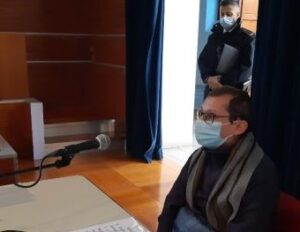
«Mia mamma ha lavorato all’Eternit per 32 anni; nell’ultimo periodo faceva i “cappelli” dei camini, li modellava con le mani. Il camice azzurro? Lo portava avanti e indietro, da casa alla fabbrica e viceversa, nel ritorno. Chi lo lavava? Se lo lavava lei. Ha sempre abitato a Casale. E quando sei di Casale e hai certi sintomi… Lei era andata in pensione con un po’ di anticipo, perché aveva l’asbestosi. La polvere nei polmoni. Non respirava bene, dormiva praticamente seduta, con due cuscini ben dritti dietro la schiena. Ma la malattia che l’ha uccisa – racconta il figlio alla Corte, presieduta da Gianfranco Pezone (affiancato da Manuela Massino e da sei giudici popolari) – non è stata l’asbestosi, ma il mesotelioma. Si è manifestato a luglio 2003. Il primo sintomo: qualche problema all’intestino. Mentre la preparavano per fare gli accertamenti, lei ha sentito un infermiere che diceva al medico “è una donna di 71 anni che ha lavorato per molto tempo all’Eternit”. E mia mamma ha capito: se abiti a Casale, lo sai!».
Roberto Beccaria (parte civile con l’avvocato Riverditi) per la morte della madre Elda Costanzo.
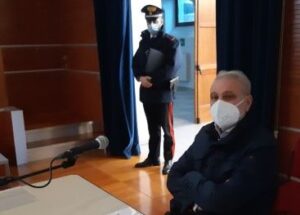
«Mia mamma, da giovane, faceva la camiciaia; poi ha lavorato in un’agenzia per la distribuzione dei giornali e infine è stata bidella. Ma si occupava anche della casa, e pure del bucato, incluso il lavaggio della tuta impolverata di mio padre, che dagli anni Sessanta fino alla chiusura nell’86 è stato operaio all’Eternit. Fatta la diagnosi, mio papà, che l’ha accudita per tutto il tempo della malattia, da agosto 2008 al 4 febbraio 2009, ha scelto di non dirle che cosa aveva: lei era molto apprensiva, non avrebbe retto. Quando era nato mio figlio, la mamma era felicissima di poter accudire il nipote; il suo grande desiderio era di vederlo crescere. Invece, quando è morta, lui non aveva neppure otto anni». Gli viene domandato se nel cortile di casa era stato usato il polverino: «Sì, risponde, lo si impiegava per “stabilizzare” la superficie e, già solo camminandoci sopra, tiravi su polvere a ogni passo».
Beatrice D’Ambrosio (parte civile con l’avvocato Riverditi) per la morte del padre Walter D’Ambrosio.
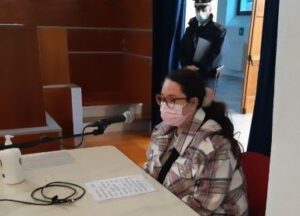
«Mio padre era un uomo molto giovanile, attivo, partecipava a molte gite. Aveva vissuto diversi anni a Casale, quando lavorava in banca, poi si era trasferito a Vercelli, ma in città tornava spesso, perché c’erano tutti gli amici e il fratello, in via Cavour, in centro. A settembre 2013, è comparsa una bronchite». Quella fu la prima ipotesi. «Tra ottobre e novembre, invece, fu fatta la diagnosi della vera malattia». Mesotelioma. «Mio papà non ha reagito bene – ricorda la figlia -; mia mamma era già morta per un tumore e lui si è subito reso conto di non avere un futuro. Di tutte le attività che faceva, beh… non ha più potuto fare nulla. A gennaio si è tentata la chemioterapia, ma non è riuscito neppure a fare la terza dose, perché stava troppo male. Ad aprile 2014 è morto».
Assunta Prato (parte civile con l’avvocato Riverditi) per la morte del marito Paolo Ferraris.
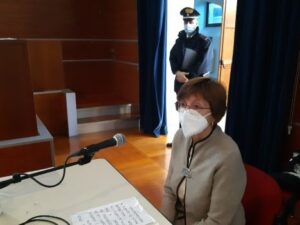
«Era mio marito, ci eravamo sposati nel 1975. Quando è morto, non aveva ancora compiuto 49 anni». Assunta e Paolo insieme hanno sempre vissuto a Casale, dove lui (che è stato capo dell’Ufficio Studi del Comune di Alessandria) si è impegnato attivamente in politica, ricoprendo ruoli di rilievo nell’amministrazione pubblica casalese e, successivamente, anche in ambito regionale (fu consigliere e assessore). «I primi sintomi si manifestarono a fine ’93: un po’ di tosse, ma sembrava una cosa banale. Però, non passava». A marzo decisero di fare degli approfondimenti e la diagnosi fu implacabile: mesotelioma. Lui era consapevole? «All’inizio sì – ha spiegato la vedova -, anche se il nome della malattia era preceduto dall’aggettivo “probabile” e “non accertato”. Ci consigliarono di rivolgerci all’ospedale San Luigi di Orbassano, per valutare l’eventualità di un intervento chirurgico». Il ricordo è pesante; per ogni dettaglio rivissuto, la voce si incrina. «Il primario mi prese da parte, mi confermò la diagnosi e mi disse che, secondo lui, era meglio non fare niente: né l’intervento chirurgico né la chemioterapia, perché in entrambi i casi sarebbe stata fortemente compromessa la qualità della vita». Ma aggiunse un altro suggerimento: negargli la verità. «Io replicai che Paolo non avrebbe mai creduto a una simile bugia!». Paolo Ferraris faceva parte della squadra dell’allora sindaco Riccardo Coppo che, nell’87, aveva firmato la famosa ordinanza che vietò a Casale, prima città in Italia e cinque anni prima dell’approvazione della legge nazionale, qualunque impiego di amianto (produzione, lavorazione, commercializzazione). Paolo Ferraris conosceva perfettamente la gravità del cancro dell’amianto. Anzi, da amministratore pubblico, nel 1994 riuscì a far stanziare dalla Regione Piemonte i primi tre miliardi di lire che diedero inizio alle bonifiche nel territorio di Casale. «Ma il primario mi disse che, se io me la fossi sentita, lui era disposto ad avvalorare la tesi con un foglio ambiguo da consegnare al medico curante». Assunta Prato accettò di caricarsi da sola tutto il peso, condiviso soltanto con pochissimi amici fidati e riservati. «Quando uscimmo dallo studio di Orbassano, Paolo si sentiva consolato, perché aveva temuto la diagnosi di mesotelioma e invece… Mi pose nelle mani il foglio che gli aveva consegnato il chirurgo, “pensaci tu a darlo al nostro medico”». In questo modo passarono due anni: «All’inizio, la qualità della vita era abbastanza buona, ma poi la situazione cominciò a peggiorare, con dolori, mancanza di forze. Aveva perso 25 chili». Il male lo rosicchiava con voracità implacabile. «Pure ai nostri tre figli non avevo detto nulla, ma arrivò il momento di metterli a parte di tutto. E, subito dopo, era l’agosto del ’96, lo dissi anche a Paolo». E lui come reagì? Fino a questo momento il ricordo di Assunta Prato si è concretizzato in una narrazione piana e misurata, con l’attenzione rispettosa ed empatica di giudici e avvocati, coinvolti in tutte queste dolorose storie allineate lungo una pellicola in bianco e nero, ma punteggiata dei colori della vita vissuta. Paolo Ferraris come reagì? Lo sa bene Assunta Prato come reagì suo marito e il pianto, dapprima tenuto a bada con severo pudore, prorompe, gonfia la gola e la chiude, lascia uno spiraglio solo a un singhiozzo. «Mi disse – riesce a riprendersi – che gli avevo regalato due anni di vita». Negli ultimi tempi, «quando non si reggeva più sulle gambe da solo, oltre a me anche i nostri figli lo aiutavano a muoversi, fino all’ultimo giorno». Morì il 2 dicembre 1996 nella loro casa.
Maria Grazia Rosso Chioso (parte civile con l’avvocato Paolo Liedholm) per la morte del marito Giovanni Numico.
«E’ stato mio marito per 35 anni: il compagno ideale, con cui ho condiviso una vita piena, il mio punto di riferimento. La sua mancanza mi ha provocato un forte smarrimento». Numico, imprenditore casalese, è stato dapprima contitolare di un magazzino all’ingrosso di generi alimentari e coloniali, e, successivamente, socio nella tipografia Diffusioni Grafiche fino al 2002, quando orientò e concentrò gli affari nel settore dell’editoria, gestendo testate giornalistiche nel Verbano. «Ha cominciato a non stare bene a novembre 2004: aveva un gran dolore alla schiena che, nonostante le cure, non passava. Il 12 gennaio 2005, ha fatto una lastra e ne è venuto fuori che aveva l’acqua nei polmoni. Da lì è cominciato tutto il calvario». Quando gli è stata comunicata la diagnosi, «al professore ha detto: “Ho bisogno di sette mesi per mettere a posto le cose, sistemare gli affari di famiglia”». Il suo pensiero principale era quello di garantire ogni tutela possibile alla moglie e alla figlia. «Chiese sette mesi di tempo, il resto non lo interessava più – ha raccontato Maria Grazia Rosso Chioso -. E quando, facendo i vari esami, gli dicevano che il male era “fermo”, lui rispondeva, rassegnato, che il tempo ormai era scaduto». Morì il 1° giugno 2006. Lasciò anche una somma da destinare alla ricerca: fu fondata, in sua memoria, l’associazione «Oltre il mesotelioma».
Sonia Bonino (parte civile con l’avvocato Esther Gatti) per la morte del padre Massimo Bonino.
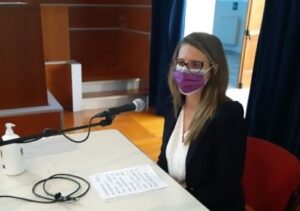
«Mio padre era uno sportivo, aveva un fisico asciutto e sano: andava in bicicletta e in moto. E, poi, aveva la passione della musica. Suonava in un gruppo, anche ai matrimoni e alle sagre. Passioni che coltivava nel tempo libero». Di mestiere «faceva il rappresentante di forni per la panificazione e di impianti frigoriferi per negozi e bar. E’ vissuto tra Casale e Vercelli, ma a Casale ci tornava sempre, sia per motivi professionali sia perché aveva qui sua madre, la sorella minore e uno zio, e gli amici e gli hobby». Finché, tra novembre e dicembre 2009, è comparsa una tosse che si è fatta, via via, sempre più insistente. «Mio padre era un tipo ipocondriaco e leggere sul Monferrato (il bisettimanale locale, ndr) le notizie che riguardavano persone che si ammalavano di mesotelioma, lo rendeva consapevole e preoccupato al pensiero che anche a lui potesse…». E così accadde: dopo la diagnosi a inizio 2010, si affidò alle cure dell’equipe chirurgica di Brescia: «A marzo gli fu asportato il polmone malato. Dopo l’operazione, non è mai più stato bene, ma in qualche modo ha tirato avanti, fino a maggio 2011, quando le sofferenze lo opprimevano in modo pesante, aveva dolori forti, faticava a respirare per via dei polmoni pieni d’acqua, non riusciva a vestirsi. Disse che, a saperlo, forse non era stata l’idea più giusta fare l’intervento chirurgico».
Fin da subito non si era fatto nessuna illusione: era consapevole che sarebbe morto. Ma dopo lo choc iniziale, divenne super-razionale: fece il testamento biologico e mise tutto a posto in banca e all’assicurazione. Si recò anche all’Hospice di Casale per informarsi personalmente, fin da subito, del destino che lo attendeva, temeva la sofferenza fisica. E lì ha chiesto di essere accudito, quando fosse arrivato il momento, perché non voleva pesare sulla famiglia». Negli ultimi mesi, si tentò anche la chemioterapia, «ma senza efficacia, su un fisico così debilitato: pesava ormai 45 chili!». Quando, alla fine, fu accolto all’Hospice, «aveva grosse difficoltà a respirare, a nutrirsi. E’ morto a luglio 2011». Il musicista sportivo Massimo Bonino aveva 57 anni.
Marco Scagliotti (parte civile con l’avvocato Riverditi) per la morte della madre Rosa Grangia.
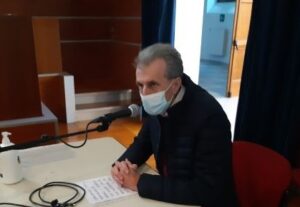
«Mia mamma era una donna energica, una in gamba, vissuta a Rolasco, frazione appena sopra Casale, vicinissima in linea d’aria all’Eternit. Era casalinga, ma curava anche il frutteto, l’orto e aveva un giardino stupendo». Le avvisaglie del male sono comparse a fine 2014. «Accadde una brutta sera – ha ricordato il figlio -, non me la dimenticherò mai. Il 17 dicembre. Ero a cena con dei colleghi fuori città. Mi chiamò al telefono. Strano, mi dissi, non mi disturbava mai. “Marco, ho tanto male al fianco destro”. Io ero a cento chilometri di distanza, intervenne la guardia medica, poi in ambulanza fu portata al Pronto Soccorso. Arrivai in ospedale all’una di notte e appresi che c’era un esteso versamento pleurico. Lì per lì non ho capito. Nei giorni successivi, dopo la Tac, lo pneumologo, il dottor Piccolini, le fece la toracentesi. Quando fu dimessa, mi diedero un foglietto con sopra scritto “mesotelioma bifasico maligno”». E sua madre come reagì? «Nella prima fase con speranza; mi domandò: “Marco, pensi che me la cavo?”. Un mese dopo era già meno fiduciosa: “Qui mi sa che faccio la fine della Laura”, una signora morta di mesotelioma. A giugno, scuoteva la testa: “Mica io sono una donna da fermarmi!”. Finché un giorno, specchiandosi commentò su di sé: “Va’, va’, che faccia da via Negri che ho!” (via Negri è il luogo dove si trova il cimitero di Casale, ndr). E’ vissuta sei mesi dalla diagnosi, di cui metà tempo trascorso in ospedale.
Maria Paola Soffiantino (parte civile con l’avvocato Riverditi) per la morte della madre Gianfranca Piano.
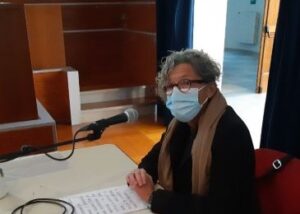
«La mia mamma è nata a Sala, ma ha trascorso buona parte della vita a Casale, tranne un periodo a Ivrea. Lei, me lo ricordo, diceva che “qui a Casale c’è molta più polvere che a Ivrea!”. E’ stata prima casalinga e, poi, venditrice a domicilio di contenitori alimentari e pentole». I sintomi della malattia si manifestarono nell’estate del 2002: «Aveva dolori addominali e faticava a respirare. A settembre, fu riscontrata la presenza di liquido nei polmoni. Fu analizzato e, per due volte, con esito negativo». Che dire? Gli accertamenti proseguirono, anche con la biopsia che confermò i timori: «La diagnosi – mesotelioma pleurico sarcomatoso – fu comunicata l’8 novembre 2002». Maria Paola Soffiantino si ferma un attimo e riflette, poi: «Già, oggi (giorno dell’udienza, ndr) è la stessa data di diciannove anni fa». Il ricordo è nitido: «Mia mamma sapeva tutto della gravità della malattia e della fine certa. Per un po’ di mesi, conservò una certa autosufficienza: camminava, badava a sé stessa, si teneva in ordine, guardava la tv, leggeva. Fino a novembre 2003, quando le fu assegnata l’assistenza domiciliare e fu necessario l’ossigeno. Del suo grande giardino, della montagna, non le interessava più». Aveva un cruccio: «Riuscirò a trascorrere il Natale con i miei figli e i miei nipoti?». No, per un soffio; morì il 21 dicembre 2003.
Alessia Natta (parte civile con l’avvocato Riverditi) per la morte della madre Giovanna Buso.
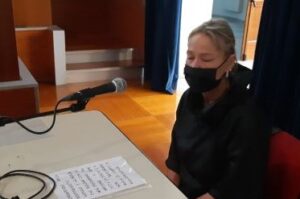
«La mamma, dopo esser rimasta vedova alla morte di mio papà, si era risposata. Il suo secondo marito lavorava all’Eternit, operaio dal 1963 al 1986. Chi lavava le sue tute? Lei, ovviamente, e, anzi, prima di metterle in lavatrice, le scuoteva ben bene perché erano tanto impolverate». Il «calvario tremendo» è cominciato nel 2007: «Aveva tanto male a un braccio e a una spalla. E’ stata visitata, ha fatto la Tac, ma non veniva fuori niente. Eppure le cose non andavano bene, faticava seriamente a camminare. Ha rifatto la Tac ad Alessandria ed è venuta fuori questa “bella” macchia ai polmoni». E che cos’era «’sta bella macchia»? «Era il mesotelioma. Mia mamma aveva grosse difficoltà a muoversi e fu sottoposta a un intervento alla colonna vertebrale, ma, dopo pochi mesi, rimase completamente paralizzata, fatta eccezione per la testa e le mani. Lei era lucida, eh! E’ stata lucida e cosciente fino a un’ora prima di entrare in coma. Ce la siamo curata io e le mie figlie, una faceva il liceo e l’altra l’università, ci davamo i turni. Io non sapevo più che cosa raccontare a mia madre quando mi guardava negli occhi…». Altre fibre fatali avevano già colpito questa famiglia: «Anche mio nonno, il padre di mia madre, che aveva lavorato all’Eternit, è morto della stessa malattia. Quando era andato in pensione, aveva lasciato il posto in fabbrica a suo figlio, mio zio. Pure lui ha fatto la stessa fine».
Andrea Chiesa (parte civile con l’avvocato Riverditi) per la morte del padre Domenico Chiesa.
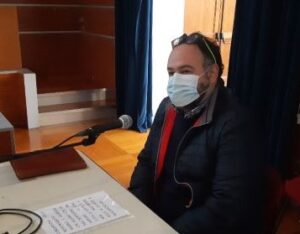
«Papà, da ragazzo, aveva fatto l’operaio in un salumificio a Casale. Poi, dall’inizio degli anni Sessanta, ha cambiato attività: è diventato agente assicurativo». La prima sede degli uffici in via Liutprando, poi il trasferimento in piazza Castello (700-800 metri dallo stabilimento Eternit), nel 1976: una delle agenzie assicurative più note in città. «A giugno 2011, si manifestarono i primi sintomi: fiato corto, tosse, male alla schiena. Un giorno – ricorda il figlio – mentre era nell’orto, ebbe un giramento di testa e svenne». Fu trasportato in ospedale «e da lì è iniziato tutto: durante gli accertamenti fu notato qualcosa ai polmoni». La diagnosi arrivò lapidaria. «Nel giro di pochi mesi, tra agosto e novembre, perse peso e autonomia; la mamma gli stava dietro in tutto, negli ultimi giorni lo imboccava. Sì, papà sapeva che cosa stava succedendo, ma non ne parlavamo. Prima gli piaceva incontrare la gente, curare l’orto. Con la malattia, non riusciva più». E’ morto l’11 novembre 2011.
Davide Sorisio (parte civile con l’avvocato Riverditi) per la morte della madre Marisa Petrini.
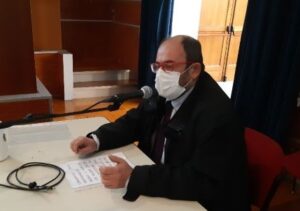
«Mia madre, originaria di Ponzano, si è trasferita a Casale quando si è sposata. Era maestra elementare: ha insegnato alla scuola XXV Aprile, di Oltreponte, e alle Martiri, in piazza Castello. Quanto distante dall’Eternit? Mah, circa un chilometro e mezzo, forse meno». Era anche impegnata come catechista in parrocchia. E’ morta di mesotelioma il 22 febbraio 2015. «Tra fine agosto e settembre del 2012, ha cominciato ad avvertire un respiro affannoso, un affaticamento e una spossatezza crescenti. Le mancava proprio il fiato. Un giorno – ricorda il figlio -, quando è rincasata dopo una breve passeggiata, ho notato che aveva… come dire… fame d’aria, e per almeno mezz’ora non riuscì a ossigenarsi. Decidemmo di fare accertamenti, a Casale e a Novara, e arrivò il responso». Lei sapeva? «Lo pretese: “Qualunque cosa – ammonì me e mia sorella – fatemela sapere». Per un po’ di tempo conservò una certa autonomia, «ma nella fase terminale no, aveva sempre più bisogno di aiuto».
Paola Perotto (parte civile con l’avvocato Paolo Liedholm) per la morte della madre Santina Caprioglio.
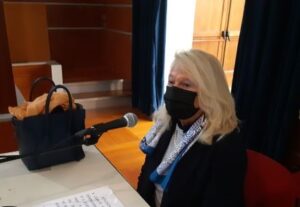
«Mia madre era casalinga. Mia sorella e io abbiamo contato molto su di lei, anche quando ci siamo fatte una famiglia. Era nata a San Giorgio Monferrato, ma quando si è sposata con papà, cui è sempre stata legatissima, si è trasferita a Casale. Abitavamo in corso Indipendenza». Era una delle strade di più intenso traffico dei camion che dallo stabilimento Eternit al Ronzone raggiungevano i magazzini in piazza d’Armi e la stazione ferroviaria lì vicino. «Certo che li ricordo i camion, con due rimorchi, che trasportavano le lastre, e non c’era nessun telone di protezione. Qualche volta, sul curvone, parte del carico cadeva giù e si rompeva. Gli stessi autisti scendevano e lo spazzavano a colpi di scopa, sollevando un bel polverone». Qualcosa di insolito si manifestò nell’estate 2001, «mentre eravamo in vacanza a Varazze. La mamma dimagrì molto e, se faceva anche solo due gradini, andava in affanno». Poiché c’era una famigliarità con malattie cardiache, fu sottoposta a elettrocardiogramma, ma il medico suggerì un approfondimento polmonare. Lo stato di salute si andava progressivamente aggravando. «Eravamo molto preoccupati; il dottor Piccolini, lo pneumologo, accettò di visitarla l’8 dicembre, nonostante la data festiva. Lì non disse nulla. Poi telefonò a me e a mia sorella e ci spiegò che un polmone era mezzo invaso dal liquido. In ospedale fecero la Tac e la broncoscopia; ci dissero che, ancor prima che arrivassero gli esiti, il colore del liquido prelevato avrebbe subito potuto fornire un’indicazione. Purtroppo, la colorazione del liquido prelevato era quella “sbagliata”. Durante la broncoscopia, mentre ero in corridoio sentivo i lamenti di mia madre. Sono corsa nella cappella e ho pregato: ho pregato che non fosse “quello” il responso». E invece lo era. «Mia sorella e io convenimmo con il medico che fosse meglio non farglielo sapere: se avesse saputo quel che aveva davvero, si sarebbe buttata da una finestra. La mamma aveva avuto una pleurite trascurata; ci attaccammo a quella spiegazione, le fu prescritta una certa terapia e per un po’ la cura ebbe qualche effetto. Ma i medici ce lo avevano detto: 18 mesi di vita. Non sbagliarono. Nella caldissima estate del 2003 – prosegue la figlia – portammo la mamma in montagna, pensavamo che potesse farle bene; invece, si aggravò, le mancava l’aria. Tornammo a casa; serviva l’ossigeno, negli ultimi quindici giorni era quasi incosciente. Morì il 30 agosto 2003 nel suo letto». E lei? «Io? Io vivo nel timore. La mia generazione ha visto morire tante persone di mesotelioma, anche della mia età. Nel palazzo in corso Indipendenza dove abitavano i miei genitori, almeno quattro o cinque persone, che io sappia, sono morte di mesotelioma».
Barbara Sarzano (parte civile con l’avvocato Esther Gatti) per la morte della madre Graziella Martinelli.
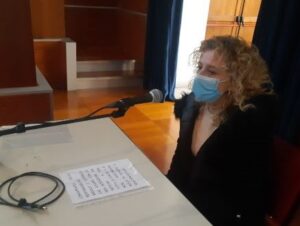
«Mia mamma faceva la sarta. Riparazioni di abiti. La nostra era una famiglia molto, molto unita. Sua sorella Amedea, che in realtà tutti chiamavamo Gabriella, ha lavorato all’Eternit per molti anni. Quando usciva dalla fabbrica, faceva sempre una sosta da mia mamma, erano legatissime. Come arrivava la zia? Ah, così com’era vestita quando usciva dal lavoro». La casa di mia madre era in via Signorini, una traversa di viale Marchino, al Priocco. «La mamma si spostava sempre in bicicletta. Ecco, a un certo punto ha cominciato a fare con fatica la salita che prima affrontava con naturalezza: ora, era costretta a fermarsi a metà. Dopo una vacanza con papà, decisero che era utile fare una visita. Già subito dopo la lastra, i medici dissero che era “quello”. Mi sono arrabbiata molto». Con chi? «Con Dio: ma possibile che, con tutti i tumori che ci sono, proprio “quello” che non si poteva curare?». Le hanno dato tre mesi di vita: «Invece è campata tre anni». Come? «Per un po’ abbastanza bene, ma, negli ultimi sei mesi, le hanno applicato la macchinetta per somministrare la morfina, tanto era il dolore: non ne poteva più. Papà, più di tutti, l’ha accudita e l’ha curata fino alla fine: praticamente, gli è morta tra le braccia».
Maria Balsamo (parte civile con l’avvocato Gatti) per la morte del marito Giancarlo Sboarina.
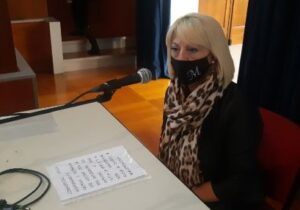
«Mio marito, quando è morto di mesotelioma, aveva compiuto quarant’anni da pochi giorni. Era una persona sanissima, un ragazzo fortissimo. Io abitavo a Chivasso, lui a Casale. Quando ci siamo conosciuti, avevo 14 anni e lui 21». Si vollero tenacemente fin da subito. «Per un paio d’anni, facevamo la spola: ora veniva lui da me, ora venivo io da lui. Poi mi trasferii a Casale, all’inizio nella casa dei suoi genitori, ero molto giovane. Successivamente, traslocò qui anche mia madre. Finché, nell’84, ci sposammo. Giancarlo lavorava alla Iarp: ha cominciato come operaio, poi è diventato responsabile di reparto. I suoi genitori, invece, erano all’Eternit. Mio suocero aveva l’asbestosi; è andato in pensione nel ’71, ma è morto a 55 anni per via dell’amianto. E mia suocera è mancata l’anno prima di mio marito». Il momento terribile per Maria e Giancarlo si colloca nel 1996: «A settembre, tornati dalle vacanze, lui lamentava un forte male alle spalle e alla schiena, ed era comparsa la febbre. Aveva 36 anni, solo 36 anni! E gli trovarono l’acqua nei polmoni». Furono fatti ulteriori approfondimenti e «arrivò la diagnosi che non avrebbe mai dovuto arrivare». Da quel momento «la vita – Maria non riesce più a contenere le lacrime – la vita non è stata più vita. Proprio quando eravamo pronti a far prendere il volo al nostro progetto: avevamo due bambini, volevamo comprare una casa nostra…». All’inizio, lui non sapeva della malattia: «Non volevo che lo sapesse. Io mi sdoppiavo, in casa mettevo la maschera per dare forza a lui e ai bambini. Poi è mancata mia suocera, a gennaio 1997. Da lì, mio marito ha cominciato a capire. Io mi sono presa cura di lui, fino a che è morto il 29 gennaio. Avevo i miei bambini ancora piccoli e lui non c’era più». Anche a Maria manca il respiro, succhiato dalla dolorosa memoria.
Antonella Migliaccio (parte civile con l’avvocato Gatti) per la morte della madre Adriana Daniotti.
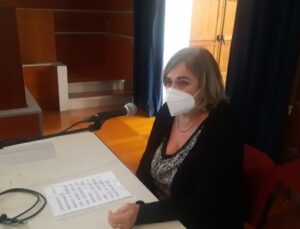
«Quando mia mamma si è sposata, a luglio del ’62, era caporeparto alla Linclalor (fabbrica di lingerie e biancheria, ndr), ma quando sono nata io, l’anno dopo, ha lasciato il lavoro e si è occupata della famiglia. Era una donna meravigliosa!». I singhiozzi hanno il sopravvento. «Scusate» mormora e riprende: «Era energica e attiva, andava in palestra, in bicicletta con le amiche e si dedicava molto agli altri, così generosa… A luglio del 2010, quando sono tornata dalle vacanze e la vidi, lei, come dire, non era più lei! Era stata in montagna, nel weekend, e non si era sentita bene. La dottoressa del posto l’aveva auscultata e aveva capito subito: così, l’aveva mandata a fare una radiografia. Se sei di Casale Monferrato sai benissimo che cosa significa: quella è una condanna a morte. E mia mamma si è sentita travolta, vinta da quella condanna: si è arresa. La vidi, in pigiama, seduta in un angolo, con la testa bassa: no, non era più la mamma di sempre. Dopo la biopsia, che confermò il mesotelioma, cominciò a darmi istruzioni: “Questo lo dai alla zia, questo lo dai a…”». Le disposizioni delle sue volontà. «Lei non voleva sottoporsi alla chemio, perché sapeva che non c’era niente da fare, ma noi abbiamo insistito, per cercare una speranza. E’ stata malissimo». I ricordi sono vividi, feroci e insopportabili. «Quando era a letto, le stavo vicino e la incoraggiavo “dormi”, perché speravo che soffrisse di meno, ma adesso penso che, invece, avrei potuto parlarle di più…».
Anna Triglia (parte civile con l’avvocato Gatti) per la morte della madre Luciana Morando.
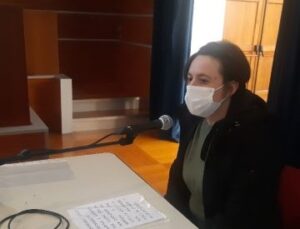
«Mia mamma stava a Casale; da ragazza lavorava all’Osteria dei Pescivivi, che era di mio nonno, poi, quando si è sposata, si è trasferita in corso Manacorda… quanto sarà? 700/800 metri dalla fabbrica Eternit… e successivamente in via Parodi. Era figlia unica; così, oltre a occuparsi di me e di mio padre, accudiva i genitori e uno zio, che abitavano in salita Sant’Anna». Poche centinaia di metri, in linea d’aria, rispetto allo stabilimento del Ronzone. «E si è occupata anche dei miei tre figli, del quarto no, perché…». Improvvisamente, cosa del tutto inconsueta, si era messa a letto. «Nell’ultima settimana di febbraio 2015, non stava bene, pensavamo a un’influenza. Ma non passava e furono fatti accertamenti: ad aprile, ci diedero la diagnosi. A metà maggio, iniziò la chemio, ma poi fu sospesa, stava male. E’ mancata a metà luglio di quell’anno: non c’è stato tempo per fare altro». E lei sapeva che male aveva? «Lo sapeva, ma non voleva nominarlo. Ha cominciato a morire quando siamo andati dal medico in ospedale. Chi vive qui, sa». La voce si inceppa nel pianto. «Scusate», bisbiglia, soffocando il dolore nel pudore. «Per le cure, mia mamma ha voluto accanto solo me e mio padre, che era un volontario della Croce Rossa e lo sapeva fare. Mi occupavo anche di mia nonna e di mio zio, che è mancato proprio durante quei mesi, perché la mamma non poteva più farsene carico. Ero incinta del quarto figlio: è nato tre mesi dopo la morte della nonna».
I Comuni, parte civile con l’avvocato Esther Gatti.
Testimoniano i sindaci: Davide Fabbri, di Ozzano; Cesare Chiesa di Rosignano; Marco Torriano di Balzola; Cesare Calabrese di Ticineto.
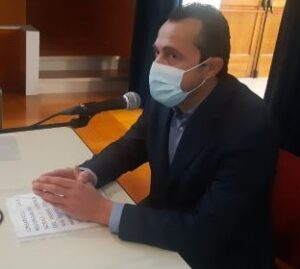
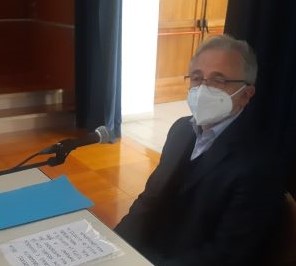
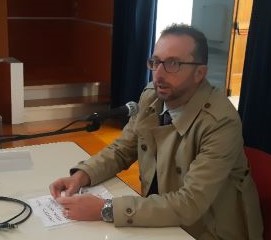
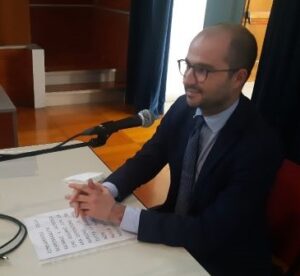
Anche alcuni Comuni monferrini, nel circondario di Casale, si sono costituiti parte civile nel processo Eternit Bis. All’udienza di lunedì 8 novembre, quattro sindaci (come aveva già fatto in precedenza Federico Riboldi, a capo dell’amministrazione del capoluogo) sono stati portavoce delle ripercussioni che l’amianto ha avuto – e continua ad avere – sul loro territorio. Intanto, per il peso, concretamente quantificabile, che ha inciso sui loro bilanci. Rosignano ha presentato documentazione contabile che attesta una spesa già sostenuta, con fondi propri, di oltre centomila euro; a Balzola l’incidenza è stata, fino a ora, di 159 mila euro di fondi propri; a Ozzano di 150 mila euro. Ticineto presenterà la documentazione a breve. In tutti i casi, si aggiungono interventi di bonifica attuati con finanziamenti statali. «Ma non è finita» hanno detto i sindaci Fabbri, di Ozzano, Chiesa, di Rosignano, Torriano, di Balzola e Calabrese di Ticineto. Mentre si può dire pressoché completata la rimozione di amianto da edifici, piazze e strade pubbliche, nelle abitazioni private l’obbiettivo «amianto free» non è ancora stato raggiunto.
E non è tutto. «Sopra a ogni cosa, pesa la gravità delle perdite umane stroncate dalla malattia: un dramma inquantificabile sia singolarmente sia per le nostre comunità. Un impoverimento sociale enorme».
E, ancora, l’amianto ha costituito e costituisce un freno per lo sviluppo di questi territori, perché, «nonostante qui si sia bonificato più che in ogni altro luogo in Italia, permane la paura di insediarsi, come abitazione o azienda, e anche la titubanza a lasciarsi attrarre dal richiamo turistico di paesaggi che sono molto belli, addirittura inseriti nel patrimonio dell’Unesco. Fatichiamo a liberarci della cattiva immagine, pur a fronte di tanti sforzi positivi e di risultati già ottenuti, grazie, soprattutto, alla coralità, alla trasversalità e alla unità con cui le varie amministrazioni che si sono succedute nel tempo, le organizzazioni e le associazioni hanno messo al primo posto l’obbiettivo della liberazione totale dall’amianto».
Prossima udienza di lunedì 15 novembre
Saranno esaminati alcuni consulenti della procura: gli anatomopatologi Donata Bellis e Narciso Mariani e i clinici Massimiliano Bugiani (pneumologo), Pavilio Piccioni (pneumologo) e Ferruccio Perrelli (medico del lavoro). Il controesame degli stessi esperti si terrà all’udienza successiva.
Traduzione a cura di (Translation by) Vicky Franzinetti
By SILVANA MOSSANO
(precede by her comments in Italics)
I had a strong temptation to summarize the eighteen witnesses in the hearing on Monday 8 November, against Stephan Schimdeheiny (…). The temptation was to shape them into a single story, (..) filtering detail through the ‘whole’, smoothing the edges, forgetting the details, making the tragedy a little more bearable. A formula for human self-protection (so I tell myself, invoking a absolution), but at the same time a cowardly way out (in the end I admitted it to myself, roughly awaking my conscience.
I was tempted to tell the story from behind the threshold, taking a step back in listening and reporting those voices. Why? Because it is like entering your own home, where you know what has happened and what is happening, you know what it feels like, you know how it stuns you – the back of your neck, your shoulders, your throat and your bowels – the chill of despair, of inevitability and powerlessness. You know what the anguish, fear and resignation look like when you receive the fierce diagnosis of mesothelioma. Scientific definitions are of little importance: malignant, pleural, biphasic, sarcomatoid… Mesothelioma is already everything. Too much. But those voices – of wives, of children – so polite and calm that rose from behind the table in the courtroom shock me more than the thunder of an August thunderstorm, throw open the doors and windows, forcing me to cross the threshold, to listen again, word for word, and to relive, unsparingly, every reaction and feeling. I had to listen to all the voices (…) out of respect, out of love, out of memory.
The lawyers for the victims and relatives who spoke on the 8th of November 2021
Lawyer Enrico Brunoldi
Lawyer Maurizio Riverditi
Lawyer Paolo Liedholm
Lawyer Esther Gatti
Paola Maria Leporati for the death of her mother Maria Raiteri (Lawyer Enrico Brunoldi)
“She was my mum. She had always lived in Coniolo, about six kilometres from Casale. As a girl, she was a farm hand; after marrying my father, she started working in her in-laws’ bakery, which my father took over in 1972, leaving his job as a worker at Eternit where he had developed asbestosis: I remember his breath whistling and how it made it difficult for him to fall asleep. Mum devoted her whole life to her family and her work. She always helped me, especially after the birth of my son, in 1995, as a he is slightly disabled”. With her grandson, who is beautiful and very sweet, as a grandmother she developed a powerful and special relationship, she was a constant and important presence. “In August 2008, she started to feel pain in her lower abdomen; I asked a friend for an ultrasound scan. “I don’t like it so much,” he told me after the examination, “have more tests done”. In October the diagnosis came – relentlessly. She began to suffer from shortness of breath. We talked to Dr. Daniela Degiovanni (the oncologist who directed the Hospice Zaccheo in Casale and the Vitas association for years, ed.) and agreed not to have chemo, to ensure the best possible quality of life. At home, I learned to do what I had to do and I treated her according to the instructions I was given. She withdrew into herself, regretting that she could no longer be useful. In the last week, when the situation got worse, I decided to transfer her to the hospice, so that my son would not have to suffer directly from the death of his grandmother, to whom he was very attached. There, at the hospice, we were close, surrounded by affection, like being at home, in a family”.
Paolo Scarrone (lawyer Brunoldi) for the death of his father Mario Scarrone.
“My father lived in San Germano, just outside Casale, until 1961; then he moved to town and opened a shop household commodities as you had then, in Via Garibaldi, together with his sisters. The first symptoms of the disease appeared in March 2008: he struggled to climb the stairs and was always out of breath. After x-rays and other checks, mesothelioma was diagnosed. He was a sportsman, my father; as a young man he even played tamburello, as an amateur, in the indoor ball-court in Corso Indipendenza (along the route from the Eternit plant, at Ronzone, to the warehouses in Piazza d’Armi, ed.). Even when he got sick, for a while he continued to go to the Natal Palli stadium for the matches of Casale or to Milan to cheer Inter, until … My mother took care of him and was close to him, from the beginning until he died in July 2009″.
Massimo Mazzer (lawyer Maurizio Riverditi) for the death of his mother Carla Lunati.
“My mother worked at Eternit for 32 years; in the last period she made chimney covers, what we called chimney “hats”, she modelled them with her hands. The blue overall? She wore in the plant and from home to the factory and vice versa, on the way back. Who washed it? She washed it herself. She had always lived in Casale. And when you’re from Casale and you have certain symptoms…you worry. She took early retirement because she had asbestosis. The dust in her lungs. She couldn’t breathe properly, she slept practically sitting up, with two pillows firmly behind her back. “But the disease that killed her,” her son told the court, (…) “was not asbestosis, but mesothelioma. It appeared in July 2003. The first symptom: intestinal problems. While they were preparing her for the tests, she heard a nurse say to the doctor, ‘she’s a 71-year-old woman who worked for a long time at Eternit’. And my mother understood: if you live in Casale, you know what that means!”.
Roberto Beccaria (lawyer Riverditi) for the death of his mother Elda Costanzo.
“When I was young, my mother was a shirt-maker; then she worked in a newspaper distribution office and finally she was a school janitor. She also took care of the house, and even the laundry, including washing my father’s dusty overalls of my father. He was a worker at Eternit from the 1960s until it closed in 1986. Once the diagnosis was made, my father, who looked after her throughout her illness, from August 2008 to 4 February 2009, chose not to tell her what was wrong with her: she was very apprehensive, she couldn’t take it. When my son was born, my mother was overjoyed to be able to look after her grandson; she wanted to see him grow up. But when she died, he wasn’t even eight years old. He is asked if powder was used in the courtyard: “Yes,” he replies, “it was used to ‘stabilise’ the surface and, just by walking on it, you raised dust at every step”.
Beatrice D’Ambrosio (lawyer Riverditi) for the death of her father Walter D’Ambrosio.
“My father was a very young man, active, he went hiking. He had lived several years in Casale, when he worked in a bank, then he moved to Vercelli, but he often came back to the city, because all his friends and his brother lived there, in via Cavour, in the centre. In September 2013, he developed bronchitis “. That was the first guess. “Between October and November, however, the diagnosis of the real disease was made.” Mesothelioma. “My dad didn’t react well,” recalls the daughter, “my mum had already died of cancer and he immediately realised he had no future. Of all the activities he did, well… he couldn’t do anything anymore. In January, they tried chemotherapy, but he couldn’t even receive the third dose, because he was too sick. He died in April 2014.”
Assunta Prato (lawyer Riverditi) for the death of her husband Paolo Ferraris.
“He was my husband, we got married in 1975. When he died, he was not yet 49 “. Assunta and Paolo had always lived together in Casale, where he (who was head of the research Office of the Municipality of Alessandria, close by) and was actively involved in politics, holding important roles in the Casale local administration and, later, also in the region (he was both a councillor and alderman). “The first symptoms appeared at the end of 1993: a bit of a cough, but it seemed trivial. However, it didn’t go away. In March they decided to carry out further tests and the diagnosis was: mesothelioma. Was he aware? “At the beginning, he probably was ” explained the widow, “even though the name of the disease was preceded by the adjective ‘probable’ and ‘not established’. They advised us to go to the San Luigi hospital in Orbassano to see if surgery was possible”. The memory is painful; for every detail she relives, her voice fails her. “The consultant took me aside, confirmed the diagnosis and told me that, in his opinion, it was better not to do anything: neither surgery nor chemotherapy, because in both cases the quality of life would have been severely compromised. But he added another suggestion: don’t tell him the truth. “I replied that Paolo would never have believed such a lie. Paolo Ferraris was part of the team of the then mayor Riccardo Coppo who, in 1987, had issued the order banning any use of asbestos (production, processing, marketing) in Casale, the first town in Italy and five years before the national law. Paolo Ferraris knew perfectly well how serious asbestos cancer was. Indeed, as a public administrator, in 1994 he managed to get the Piedmont Region to allocate the first three billion lire, to begin the reclamation work in the Casale area. “But the head physician told me that, if I felt like it, he was willing to back up the thesis of a ‘probable meso’ with an ambiguous piece of paper to give to the attending physician. Assunta Prato agreed to bear the whole burden alone, shared with only a few trusted friends. “When we left the Orbassano office, Paolo felt consoled, because he had feared the diagnosis of mesothelioma and instead… He put the paper that the surgeon had given him into my hands, “you give it to our doctor”. Two years went by in this way: “At first, his quality of life was quite good, but then the situation began to worsen, with pain, lack of strength. He had lost 25 kilos. The evil disease gnawed away at him with implacable voracity. “I didn’t say anything to our three children either, but the time came to tell them everything. And immediately afterwards, in August ’96, I told Paolo as well”. And how did he react? Up to this point, Assunta Prato’s memory has taken the form of a flat and measured narrative, with the respectful and empathetic attention of judges and lawyers, involved in all these painful stories lined up like a black and white film, dotted with the colours of lives lived. How did Paolo Ferraris react? Assunta Prato knows very well how her husband reacted and her weeping. At first she speaks quietly, then, bursts out, tears swell in her throat and she seizes up, gasping and sobbing. “He told me,” as she recovers her voice, “that I had given him two years of life. In his last days, ‘when he could no longer stand on his own two feet, apart from me, our children helped him to move, right up to the last day’. He died on 2 December 1996 in their home.
Maria Grazia Rosso Chioso ( lawyer Paolo Liedholm) for the death of her husband Giovanni Numico.
“He was my husband of 35 years: the ideal companion, with whom I shared a full life, my point of reference. I am still lost without him”. Numico, an entrepreneur from Casale, was first co-owner of a wholesale food and colonial goods warehouse, and then a partner in the Diffusioni Grafiche printers until 2002, when he concentrated his business on managing newspaper distribution in the Verbano area. “He began to feel unwell in November 2004: he had a great pain in his back which, despite treatment, would not go away. On 12 January 2005, he had an X-ray and it turned out that he had water in his lungs. That was the beginning of the whole ordeal. When he was told of the diagnosis, ‘he told the professor: “I need seven months to get things in order, to sort out the family business”‘. His main thought was to ensure every possible protection for his wife and daughter. He asked for seven months, he was no longer interested in anything else,” said Maria Grazia Rosso Chioso, “and when they told him that the disease had “stopped” during the various examinations, he replied, resignedly, that his time was up. He died on 1 June 2006. He also left a sum of money for research: the association ‘Oltre il Mesotelioma‘ was founded in his memory.
Sonia Bonino (lawyer Esther Gatti) for the death of her father Massimo Bonino.
“My father was a sportsman, he was slim and healthy: he rode a bicycle and had a motorbike. He had a passion for music. He played in a band, even at weddings and festivals. He cultivated his passions in his spare time. He worked as a salesman for bakery ovens and refrigeration systems for shops and bars. He lived between Casale and Vercelli, but he always went back to Casale, both for professional reasons and because he had his mother, younger sister and uncle here, as well as his friends and hobbies”. All that went well until, one day between November and December 2009, a cough appeared and became more and more insistent. “My father was a hypochondriac and reading in Monferrato (the local bi-weekly, ed.) the news about people who were ill with mesothelioma made him aware and worried at the thought that he too might…’. And so it happened: after the diagnosis in early 2010, he went under a surgical team in Brescia: ‘In March, the diseased lung was removed. After the operation, he was never well again, but somehow managed to get by, until May 2011, when the suffering was weighing heavily on him, he was in great pain, he was struggling to breathe because his lungs were full of water, and he couldn’t get dressed. He said that, knowing this, it might not have been the right idea to have the surgery”. From the beginning he had no illusions: he knew he was going to die. But after the initial shock, he became super-rational: he made a living will and settled everything with the bank and the insurance company. He also went to the Hospice in Casale to gather information personally, right from the start, knowing of the fate that awaited him; he feared physical suffering. And there he asked to be cared for when the time came, because he did not want to burden his family”. In the last few months, chemotherapy was also tried, “but it was ineffective on such a weakened body: he weighed 45 kilos! When he was finally admitted to the hospice, “he had great difficulty breathing and eating. He died in July 2011’. The sportsman & musician Massimo Bonino was 57 years old when he died.
Marco Scagliotti (lawyer Riverditi) for the death of his mother Rosa Grangia.
“My mother was an energetic woman, a smart one, who lived in Rolasco, just outside Casale, very close to Eternit as the crow flies. She was a housewife, but she also had an orchard, the vegetable garden and had a beautiful garden”. The signs of illness appeared at the end of 2014. “It happened one bad evening,” recalled her son, “I will never forget it. December the 17th . I was having dinner with some colleagues out of town. She phoned me. Strange, I thought, that was out of character. “She said, “Marco, I have a lot of pain in my right side. I was a hundred kilometres away, the emergency services went, then an ambulance took her to the emergency room at the hospital. I arrived at the hospital at one o’clock in the morning and learned that there was a major pleural effusion. I didn’t understand it at the time. In the days that followed, after the CT scan, Dr Piccolini, the pulmonologist, performed a thoracentesis. When she was discharged, they gave me a piece of paper with the words ‘malignant biphasic mesothelioma’ written on it’. And how did your mother react? “Initially with hope; she asked me: “Marco, do you think I’ll get through this?”. A month later she was already less hopeful: “Here I think I’m going to end up like Laura”, a woman she knew who had died of mesothelioma. In June, she was shaking her head: ‘I’m the sort of woman who stops at nothing!’. Until one day, looking at herself in the mirror, she commented: “Go on, go on, what a Via Negri face I’ve got!” (Via Negri is where the Casale cemetery is located, ed.). She lived six months from the diagnosis, half spent in hospital.
Maria Paola Soffiantino (lawyer Riverditi) for the death of her mother Gianfranca Piano.
“My mother was born in Sala, but she spent most of her life in Casale, except for a period in Ivrea. I remember, she used to say that “there’s a lot more dust here in Casale than in Ivrea!”. She was first a housewife and then sold food containers and pots and pans, door to door to farmers’. The symptoms of the disease appeared in the summer of 2002: ‘She had abdominal pains and struggled to breathe. In September, fluid was found in her lungs. It was analysed, and twice with negative results. What can we say? The investigations continued, including a biopsy that confirmed the fears: ‘The diagnosis – sarcomatous pleural mesothelioma – was announced on 8 November 2002’. Maria Paola Soffiantino pauses for a moment and reflects, then: “Yes, today (the day of the hearing, ed.) is the same date as nineteen years ago. Her memory is sharp: ‘My mother knew everything about the seriousness of the illness and the certain end. For a few months, she was self-reliant: she walked, looked after herself, kept herself tidy, watched TV and read. Until November 2003, when she was given a home help and needed oxygen. She no longer cared about her big garden or the mountains. She had one worry: ‘Will I be able to spend Christmas with my children and grandchildren?” She died on 21 December 2003.
Alessia Natta (lawyer Riverditi) for the death of her mother Giovanna Buso.
“My mother was widowed when my father died and remarried. Her second husband worked at Eternit, he was a worker at the plant from 1963 to 1986. Who washed his overalls? She did, of course, and, indeed, before putting them in the washing machine, she shook them well because they were so dusty’. The ‘terrible ordeal’ began in 2007: ‘She had a lot of pain in one arm and one shoulder. She was examined, she had a CT scan, but nothing came of it. Yet things weren’t going well, she was seriously struggling to walk. She had another CT scan in Alexandria and this “beautiful” spot on her lungs came out. And what was ‘this beautiful spot’? “It was mesothelioma. My mum had great difficulty moving and underwent spinal surgery, but after a few months she was completely paralysed, except for her head and hands. She was lucid. She was lucid and conscious until an hour before she went into a coma and died. My daughters and I took care of her, one was at high school and the other at university, we took turns. I didn’t know what to tell my mother when she looked into my eyes…’. Other fatal fibres had already struck this family: ‘My grandfather, my mother’s father, who had worked at Eternit, had also died of the same disease. When he retired, he left his job at the factory to his son, my uncle. He also met the same end’.
Andrea Chiesa (lawyer Riverditi) for the death of his father Domenico Chiesa.
“When he was a boy, dad was as a sausage factory worker in Casale. Then, at the beginning of the 1960s, he changed jobs and became an insurance agent”. The first office was in Via Liutprando, then they moved to Piazza Castello (700-800 metres from the Eternit factory) in 1976: one of the best-known insurance agencies in the city. “In June 2011, the first symptoms appeared: shortness of breath, coughing, back pain. One day,” his son recalls, “while he was in the garden, he felt dizzy and fainted. He was taken to the hospital ‘and that’s when it all started: during the check-up something was noticed in his lungs’. The diagnosis was clear. “Within a few months, between August and November, he lost weight and autonomy. Yes, Dad knew what was happening, but we didn’t talk about it. He used to like meeting people, tending the garden. With the illness, he couldn’t do it anymore. He died on 11 November 2011.
Davide Sorisio (lawyer Riverditi) for the death of his mother Marisa Petrini.
“My mother, originally from Ponzano, moved to Casale when she got married. She was a primary school teacher: she taught at the XXV Aprile school, in Oltreponte, and at the Martiri school, in Piazza Castello. How far away from Eternit? Well, about a kilometre and a half, maybe less. She was also took Sunday School and Catechism at the local parish church. She died of mesothelioma on 22 February 2015. “Between the end of August and September 2012, she began to experience shortness of breath, increasing fatigue and exhaustion. She was out of breath. One day,” recalls her son, “when she came home after a short walk, I noticed that she was… how should I put it… hungry for air, and for at least half an hour she couldn’t breathe. We decided to have test done, in Casale and Novara, and the result came back. Did she know? “She demanded it: ‘Whatever you need,’ she admonished me and my sister, ‘let me know. For a while she retained a certain independence, ‘but not in the terminal phase, she needed more and more help’.
Paola Perotto (lawyer Paolo Liedholm) for the death of her mother Santina Caprioglio.
“My mother was a housewife. My sister and I counted on her a lot, even when we started a family. She was born in San Giorgio Monferrato, but when she married my father, to whom she has always been very attached, she moved to Casale. We lived in Corso Indipendenza. It was one of the busiest streets with the trucks that drove from the Eternit plant in Ronzone to the warehouses in Piazza d’Armi coming and going, and the railway station nearby. “Of course I remember the trucks, with two trailers, carrying the sheets, and there was no protective tarpaulin. Sometimes, on the curve, part of the load would fall down and break. The drivers themselves would get out and sweep it up with a broom, raising quite a lot of sust”. Something unusual happened in the summer of 2001, “while we were on holiday in Varazze. Mum lost a lot of weight and, if she took even two steps, she would go was short of breath”. Since she had a family history of heart disease, she had an electrocardiogram, but the doctor also suggested a pulmonary examination. Her health was gradually deteriorating. “We were very worried; Dr Piccolini, the pulmonologist, agreed to see her on December, the 8th, despite it being a holiday in Italy. He said nothing when he saw her. Then he phoned me and my sister and explained that one of her lungs was half filled with fluid. At the hospital, they took a CT scan and performed a bronchoscopy, and told us that even before the results came back, the colour of the fluid taken from the lung could give an indication. Unfortunately, the colour of the fluid taken was the “wrong” one. During the bronchoscopy, while I was in the corridor, I heard my mother’s cries. I ran into the chapel and prayed: I prayed that it wasn’t “that”. But it was. “My sister and I agreed with the doctor that it was better not to let her know: if she had known what she really had, she would have thrown herself out of a window. We decided to tell her she suffered from neglected pleurisy; we stuck to that explanation, she was prescribed some treatment and for a while it had some effect. But the doctors had told us: 18 months to live. They were not wrong. In the very hot summer of 2003,” continues the daughter, “we took mum to the mountains, we thought it would do her good; instead, she got worse, she was gasping for air. We went home; she needed oxygen, and in the last fortnight she was almost unconscious. She died on August the 30th 2003 in her bed. And you? “I live in fear. My generation has seen so many people die of mesothelioma, even people my age. In the building in Corso Indipendenza where my parents lived, at least four or five people, as far as I know, have died of mesothelioma”.
Barbara Sarzano (lawyer Esther Gatti) for the death of her mother Graziella Martinelli.
“My mum was a seamstress. Repairing clothes. Ours was a very, very closely knit family. Her sister Amedea, who we all nicknamed, worked at Eternit for many years. When she left the factory, she always stopped by my mother’s, they were very close. How did our aunt come? Ah, the way she was dressed when she left work, in overalls’. My mother’s house was in Via Signorini, a side street of Viale Marchino, in Priocco. “My mother was always going everywhere by bike. At a certain point she began to struggle up the hill, which she previously she had had no problems with: now she was forced to stop halfway up. After a holiday with Dad, they decided it would be useful to have tests. Right after the X-ray, the doctors said it was “that”. I got very angry”. With whom? “With God: but is it possible that, with all the tumours there are, just ‘that one’ that couldn’t be cured?”. They gave her three months to live: “Instead, she lived three years”. How? “For a while she was quite well, but in the last six months, she had a morphine pump, the pain was so great: she couldn’t take it anymore. Dad mostly nursed her until the end: she practically died in his arms”.
Maria Balsamo (lawyer Gatti) for the death of her husband Giancarlo Sboarina.
“My husband had just turned 40 when he died of mesothelioma. He was a very healthy person, a very strong young man. I lived in Chivasso, he lived in Casale. When we met, I was 14 and he was 21. We fell in love at first sight. “For a couple of years, we commuted: he came to me, then I went. Then I moved to Casale, at first to his parents’ house, I was very young. Then , my mother moved in too. Until we got married in 1984, Giancarlo worked at Iarp: he started out as a worker, then became shop floor manager. His parents, on the other hand, were at Eternit. My father-in-law had asbestosis; he retired in 1971, but died at 55 because of asbestos. And my mother-in-law died the year before my husband. The terrible moment for Maria and Giancarlo came in 1996: ‘In September, when we came back from holiday, he complained of a strong pain in his shoulders and back, and had a temperature. He was only 36 years old, just 36! And they found water in his lungs”. Further investigations were carried out and “the diagnosis that should never have come” was given to us. From that moment on, ‘life – Maria can no longer contain her tears – life was no longer life. Just as we were ready to live: we had two children, we wanted to buy our own house…’. At first, he didn’t know about the disease: “I didn’t want him to know. I used to wear masks at home to give him and the children strength. Then my mother-in-law passed away in January 1997. From then on, my husband began to understand. I took care of him until he died on 29 January. I my children were still young and he was gone’. Maria catches her breath, as if sucked in by the painful memory.
Antonella Migliaccio (lawyer Gatti) for the death of her mother Adriana Daniotti.
“When my mum got married, in July 1962, she was a a factory supervisor at Linclalor (a lingerie and underwear factory, ed.), but when I was born, the following year, she left her job and looked after the family. She was a wonderful woman!’Antonella starts sobbing. “She was full of energy and active, she went to the gym, she rode her bike with her friends and she helped others, so generous… In July 2010, when I came back from holiday and saw her, she was, how should I put it, no longer herself! She had been to the mountains over the weekend and wasn’t feeling well. The local doctor had examined her and immediately understood: so she was sent for an X-ray. If you’re from Casale Monferrato you know perfectly well what that means: that’s a death sentence. And my mother felt overwhelmed, overcome by that sentence: she gave up. I saw her, in her pyjamas, sitting in a corner, looking down: no, she was no longer the same mother as always. After the biopsy, which confirmed the mesothelioma, she began to give me instructions: ‘ Give this to your aunt, this you give to…'”. The provisions of her will. “She didn’t want to undergo chemo, because she knew there was nothing to do, but we insisted, to look for hope. She was so sick.” Antonella’s memories are vivid, fierce and unbearable. “When she was in bed, I stayed close to her and encouraged her to “sleep”, because I hoped she would suffer less, but now I think I could have talked to her more instead…”.
Anna Triglia (lawyer Gatti) for the death of her mother Luciana Morando.
“My mother used to live in Casale; as a girl she worked at the restaurant, the Osteria dei Pescivivi, which was my grandfather’s, then, when she got married, she moved to Corso Manacorda… what is it? 700/800 metres from the Eternit factory… and then to Via Parodi. She was an only child; so, as well as looking after me and my father, she looked after her parents and an uncle, who lived in Salita Sant’Anna“. A few hundred metres, as the crow flies, from the Ronzone plant. “And she also looked after my three children, not the fourth, because…Suddenly, quite unusually, she had gone to bed. In the last week of February 2015, she was not well, we thought it was a flu. But it didn’t pass and tests were done: in April, we were given the diagnosis. In mid-May, she started chemo, but then it was stopped, she was sick. She passed away in mid-July of that year: there was no time to do anything else”. And did she know how sick she was? “She knew, but she didn’t want to mention it. She started to die when we went to see the doctor at the hospital. Those who live here in Casale know what it means.” Anna chokes with tears. “Sorry, excuse me” she whispers, stifling her pain. “For treatment, my mum only wanted me and my dad, who was a Red Cross volunteer and knew what to do, by her side. I also took care of my grandmother and my uncle, who passed away during those months because my mother could no longer take care of them. I was pregnant with my fourth child: he was born three months after my grandmother’s death’.
The municipalities (lawyer Esther Gatti).
The mayors on the witness stand: Davide Fabbri, from Ozzano; Cesare Chiesa from Rosignano; Marco Torriano from Balzola; Cesare Calabrese from Ticineto.
Davide Fabbri, Mayor of Ozzano
Cesare Chiesa, Mayor of Rosignano
Marco Torriano, Mayor of Balzola
Cesare Calabrese, Mayor of Ticineto
A number of municipalities of the Monferrato, in the Casale district, have also joined the Eternit Bis trial as plaintiffs. At the hearing on Monday, November 8, four mayors (as Federico Riboldi, Mayor of Casale, had already done previously) spoke about the impact that asbestos has had – and continues to have – in their towns. They also spoke of the costs of dealing with asbestos and how it has affected their budgets. Rosignano presented accounting documentation that shows costs incurred, over one hundred thousand Euros; in Balzola so far, 159 thousand Euros of its own funds; in Ozzano, 150 thousand Euros. Ticineto will file the accounts shortly. In all cases, reclamation works carried out with state funding have to be added. “But it’s not over,” said Mayors Fabbri of Ozzano, Chiesa of Rosignano, Torriano of Balzola and Calabrese of Ticineto. While asbestos removal from buildings, squares and public roads is almost complete, in private homes we are nowhere near “asbestos free”. And that’s not all. “Above all, there is the seriousness of the human losses caused by the disease: an unspeakable tragedy both individually and for our communities. An enormous social impoverishment. And, again, asbestos has been and continues to block the development of these territories, because, “despite the fact that here we have cleaned up more than anywhere else in Italy, there is still a fear to move to our areas, either to live or to set up a business, and also a reluctance to be attracted by the tourist appeal of landscapes that are very beautiful, even listed as UNESCO heritage sites. We are struggling to get rid of the bad image, despite the many positive efforts and results already achieved, thanks, above all, cross party work in the local authorities over time, organisations and associations that place freedom from asbestos at the top of their list of priorities.
Next hearing on Monday 15 November
Some of the prosecution’s consultants will be heard: the pathologis Drs Donata Bellis and Narciso Mariani and the clinicians Drs Massimiliano Bugiani (pneumologist), Pavilio Piccini (pneumologist) and Ferruccio Perrelli (occupational physician). The cross-examination of those same experts will take place at the next hearing.

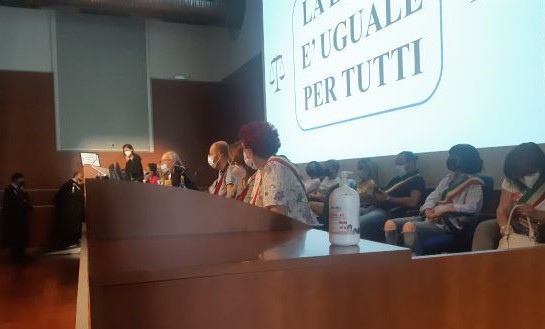
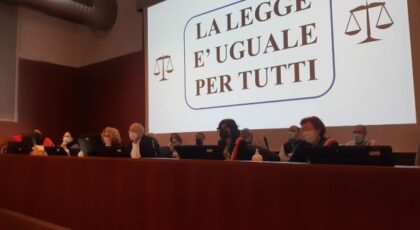
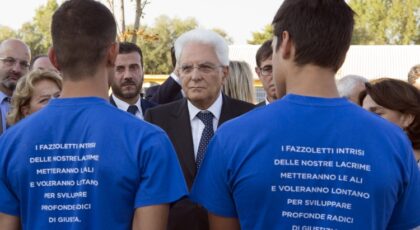
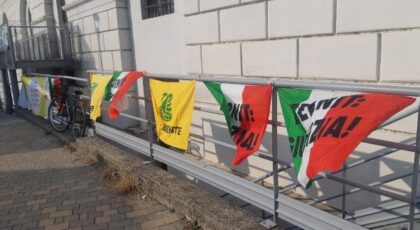
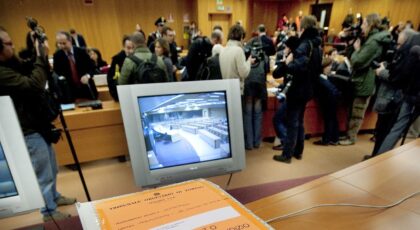
Non bisogna tacere, ma ogni parola è una spina nel cuore.
Un abbraccio a te, Silvana, con tutto il rispetto che meritano le tue parole. E un abbraccio a tutti i Casalesi che hanno dovuto partire tutto questo.
Grazie a te Silvana e alle testimonianze ,accompagnate dalla sofferenza per questa immane tragedia: sono la continuità dell’impegno responsabile per non rinunciare all’affermazione della verità e giustizia.
Ogni parola è una fitta al cuore! Rivivo il percorso di malattia al fianco di mio marito Giovanni e la rabbia mi assale . Tutti i momenti ricordati in queste storie di vita di profondo dolore che ci accomunano sono tante, troppe! Vogliamo solo giustizia e che tutto abbia fine al più presto e chi è responsabile deve pagare anche se non basterà , perché i nostri familiari non torneranno più ,ma sarà un segnale importante per tutti … vogliamo giustizia e dignità un grazie a chi ha combattuto e combatte instancabilmente con presenza, scritti e tanto coraggio! Non si deve dimenticare perché tutto questo non accada più
Grazie. È molto difficile e doloroso ma la testimonianza è la cosa più importante che possiamo dare per non dimenticare, per chi non c’è più, per chi c’è, per chi ci sarà, perché di sappia la verità, perché ci sia giustizia, perché non debba ripetersi né qui né altrove.
Ricordo quello che hai passato tu, è uno strazio leggere quello che in tanti hanno dovuto sopportare. Spero vivamente che tutto ciò non sia invano, anche se i morti nessuno li restituisce. Mi sento vicina a tutti